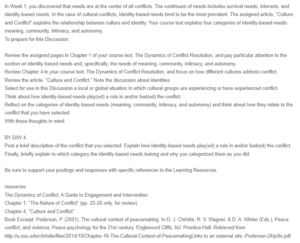Discussion – Identity-Based Needs
A Description of the Selected Conflict
I chose the dispute in Xinjiang, China, between the Uighur Muslims and the Chinese government. International attention has been drawn to this conflict by reports of violations of human rights, such as widespread detentions, monitoring, and limitations on religious and cultural traditions. Differences in politics, religion, and culture are at the core of the conflict, creating conflicts that emphasize the importance of identity-based demands like autonomy, community, and purpose (Mayer, 2012). As the Chinese government attempts to maintain control over the region, the Uighurs, an ethnic minority in China, have suffered challenges to their identity, autonomy, and community.
The Role of Identity-Based Needs in the Conflict
The conflict between the Chinese government in Xinjiang and the Uighur Muslims is largely driven by identity-based requirements. The Uighur community’s unique identity stems from their cultural, religious, and linguistic background, which puts them at odds with the Chinese government’s attempts to dominate and integrate the area. The Uighurs’ demand for autonomy, purpose, and community is directly challenged by the Chinese government’s policies, which include mass detentions, prohibitions on religious practices, and the promotion of Han Chinese culture (Holder, 2020). While the Chinese government tries to enforce its idea of a single national identity, the Uighurs want to maintain their identity as a people focused on culture and religion.
The Category in Which the Identity-Based Needs Belong
In the Uighur-Chinese conflict, identity-based demands fall into one of the four categories: meaning, community, intimacy, and autonomy. Because these aspects of their identity are closely linked to them, the Uighurs’ need to preserve their cultural and religious customs reflects their quest for significance. The struggle also affects the autonomy and community of Uighurs, underscoring the significance of these two groups in the context of cross-cultural conflicts. Based on the Uighur-Chinese conflict, which encompasses the defense of the Uighur community, the preservation of cultural and religious traditions, and the fight for autonomy against the assimilation programs of the Chinese government, the categories have been established.
References
Holder, R. (2020). On the interrelatedness of human rights, culture, and religion: considering the significance of cultural rights in protecting the religious identity of China’s Uyghur minority. The International Journal of Human Rights, 25(5), 1–22. https://doi.org/10.1080/13642987.2020.1725487
Mayer, B. S. (2012). The dynamics of conflict: A guide to engagement and intervention. John Wiley & Sons.
ORDER A PLAGIARISM-FREE PAPER HERE
We’ll write everything from scratch
Question
In Week 1, you discovered that needs are at the center of all conflicts. The continuum of needs includes survival needs, interests, and identity-based needs. In the case of cultural conflicts, identity-based needs tend to be the most prevalent. The assigned article, “Culture and Conflict” explains the relationship between culture and identity. Your course text explains four categories of identity-based needs: meaning, community, intimacy, and autonomy.

Discussion – Identity-Based Needs
To prepare for this Discussion:
Review the assigned pages in Chapter 1 of your course text, The Dynamics of Conflict Resolution, and pay particular attention to the section on identity-based needs and, specifically, the needs of meaning, community, intimacy, and autonomy.
Review Chapter 4 in your course text, The Dynamics of Conflict Resolution, and focus on how different cultures address conflict.
Review the article, “Culture and Conflict.” Note the discussion about identities.
Select for use in this Discussion a local or global situation in which cultural groups are experiencing or have experienced conflict.
Think about how identity-based needs play(ed) a role in and/or fuel(ed) the conflict.
Reflect on the categories of identity-based needs (meaning, community, intimacy, and autonomy) and think about how they relate to the conflict that you have selected.
With these thoughts in mind:
BY DAY 4
Post a brief description of the conflict that you selected. Explain how identity-based needs play(ed) a role in and/or fuel(ed) the conflict. Finally, briefly explain to which category the identity-based needs belong and why you categorized them as you did.
Be sure to support your postings and responses with specific references to the Learning Resources.
resources
The Dynamics of Conflict: A Guide to Engagement and Intervention
Chapter 1, “The Nature of Conflict” (pp. 25-28 only, for review)
Chapter 4, “Culture and Conflict”
Book Excerpt: Pederson, P. (2001). The cultural context of peacemaking. In D. J. Christie, R. V. Wagner, & D. A. Winter (Eds.), Peace, conflict, and violence: Peace psychology for the 21st century. Englewood Cliffs, NJ: Prentice-Hall. Retrieved from http://u.osu.edu/christie/files/2014/10/Chapter-16-The-Cultural-Context-of-PeacemakingLinks to an external site.-Pedersen-2ihjo9s.pdf
Note: You are only required to read pp. 3–10 and 16–19 of this chapter.
LeBaron, M. (2003). Culture and conflictLinks to an external site. Retrieved from https://www.beyondintractability.org/essay/culture-conflict
LeBaron, M. (2003). Culture-based negotiation stylesLinks to an external site. Retrieved from https://www.beyondintractability.org/essay/culture-negotiation
Mind Tools. (2009). Hofstede’s cultural dimensions: Understanding workplace values around the world links to an external site. Retrieved from https://geerthofstede.com/culture-geert-hofstede-gert-jan-hofstede/6d-model-of-national-culture/
Geert Hofstede™ 6-D Model of National CultureLinks to an external site.
https://geerthofstede.com/culture-geert-hofstede-gert-jan-hofstede/6d-model-of-national-culture/
Use the maps on this website and the information in the ‘The dimensions explained’ tab to help you compare cultures.

